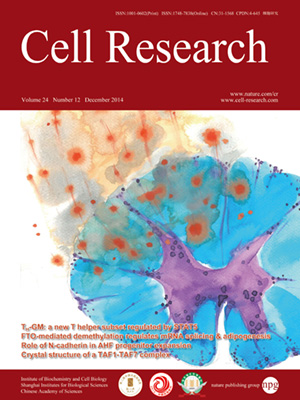
Volume 24, No 12, Dec 2014
ISSN: 1001-0602
EISSN: 1748-7838 2018
impact factor 17.848*
(Clarivate Analytics, 2019)
Volume 24 Issue 12, December 2014: 1420-1432 | Open Access
ORIGINAL ARTICLES
N-cadherin prevents the premature differentiation of anterior heart field progenitors in the pharyngeal mesodermal microenvironment
Boon-Seng Soh1,2,3,4,*, Kristina Buac1,2,5,*, Huansheng Xu1,2,3,*, Edward Li1, Shi-Yan Ng2, Hao Wu1,2, Jolanta Chmielowiec1,2, Xin Jiang1,2, Lei Bu1,2,3, Ronald A Li3,6, Chad Cowan1,2 and Kenneth R Chien1,2,4
1Cardiovascular Research Center, Massachusetts General Hospital, 185 Cambridge Street, Boston, MA 02114, USA
2Department of Stem Cell and Regenerative Biology, Harvard University and Harvard Medical School, 7 Divinity Avenue, Cambridge, MA 02138, USA
3Stem Cell & Regenerative Medicine Consortium, and the Department of Physiology, LKS Faculty of Medicine, The University of Hong Kong, Hong Kong SAR, China
4Department of Cell and Molecular Biology and Medicine, Karolinska Institute, 171 77 Stockholm, Sweden
5Department of Biochemistry and Molecular Biology, University of Georgia, Athens, GA 30602, USA
6Center of Cardiovascular Research, Mount Sinai School of Medicine, New York, NY 10029, USA
Correspondence: Kenneth R Chien,(kenneth.chien@ki.se)
The cardiac progenitor cells (CPCs) in the anterior heart field (AHF) are located in the pharyngeal mesoderm (PM), where they expand, migrate and eventually differentiate into major cell types found in the heart, including cardiomyocytes. The mechanisms by which these progenitors are able to expand within the PM microenvironment without premature differentiation remain largely unknown. Through in silico data mining, genetic loss-of-function studies, and in vivo genetic rescue studies, we identified N-cadherin and interaction with canonical Wnt signals as a critical component of the microenvironment that facilitates the expansion of AHF-CPCs in the PM. CPCs in N-cadherin mutant embryos were observed to be less proliferative and undergo premature differentiation in the PM. Notably, the phenotype of N-cadherin deficiency could be partially rescued by activating Wnt signaling, suggesting a delicate functional interaction between the adhesion role of N-cadherin and Wnt signaling in the early PM microenvironment. This study suggests a new mechanism for the early renewal of AHF progenitors where N-cadherin provides additional adhesion for progenitor cells in the PM, thereby allowing Wnt paracrine signals to expand the cells without premature differentiation.
10.1038/cr.2014.142
FULL TEXT | PDF
Browse 2030


